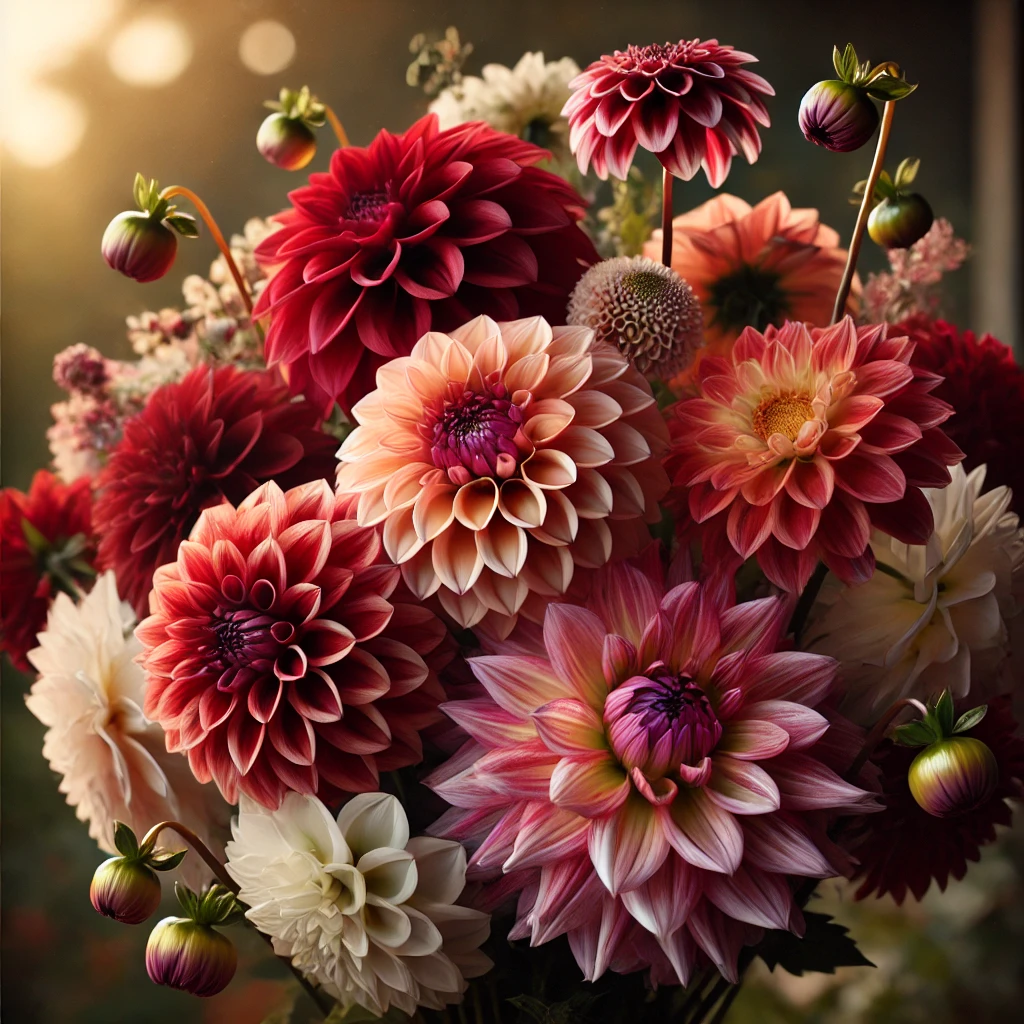
A Complete Guide to Digging, Dividing, Storing, and Growing Dahlias
Dahlias are a favorite among gardeners for their stunning blooms and long growing season. To keep your dahlias thriving year after year, it’s important to properly dig, divide, store, and wake up your tubers during the late fall and into winter months. In this guide, I will walk you through everything you need to know, from lifting your tubers in the fall to planting them out around Mother’s Day weekend.
How and When to Dig and Divide Dahlia Tubers
Dahlias are not frost-hardy, so the best time to dig them up is after the first frost blackens the foliage. This usually happens in late fall, depending on your climate. For me, in zone 8b, our first frost date for 2024 was supposed to be October 31st, but the first frost didn’t arrive for a couple of weeks after that date.
Steps to Digging Up Dahlias:
- Cut Back the Foliage – Once frost has killed the foliage, cut the stems down to about 4-6 inches above the ground. Ensure each dahlia plant is labeled to make it easier to organize the tubers when dividing. I like to use flaggers tape and tie it around the dahlia stalks.
- Loosen the Soil – Using a garden fork or shovel, carefully loosen the soil around the tuber clump, being mindful not to pierce or damage them. It is recommended to go out from the stalk 1 – 1.5 feet and insert your garden fork or shovel.
- Lift and Shake Off Soil – Gently lift the tuber clump from the ground and shake off excess soil. Hose them off if necessary, but avoid soaking them too much. Leave them out to dry off from hosing them off before storing them.
- Let Them Cure – Place the clumps in a cool, dry place for about a week to allow the skins to toughen before dividing. This helps for when you go to label them and to protect them through winter.
Dividing Dahlia Tubers:
Dividing dahlia tubers helps ensure healthy plants and more blooms next season. It also is one of the best ways to propagate your dahlia varieties, which if you plan to sell tubers, it will be a great tool. Here’s how to do it:
- Inspect the Clump – Look for firm, plump tubers. I usually start by cutting the root off of the tubers to look for any rot. Rot will appear as discoloration, brown color inside the tubers. If you find any rot, keep cutting up the body until you see clean tuber flesh which will be white in color. Discard any tubers that are soft, moldy, rotting, or shriveled.
- Find the Eyes – The “eyes” (growth points) are located at the base of the stem. Each division must have at least one viable eye on the head, a neck and the body to grow.
- Cut with a Sharp Knife, Scissors, or Pruners – Use a clean, sharp knife, scissors, or garden snips to separate the tubers. You want to cut at the head, located at the base of the plant stalk and ensure it includes at least one eye.
- Label Your Varieties – If you have multiple dahlia varieties, label them now to avoid confusion in the spring. There are multiple options for labeling including garden markers and stamps.
How to Store Dahlia Tubers in Plastic Tubs with Vermiculite
Proper storage prevents tubers from rotting or drying out during the winter months. One of the best methods is storing them in plastic tubs with vermiculite.
Steps for Storing Dahlia Tubers:
- Choose a Container – I like to use plastic tubs with lids which will hold in moisture to help prevent the tubers from drying out.
- Prepare the Vermiculite – Pour a layer of dry vermiculite into the bottom of the tub. Vermiculite is great for storing tubers to prevent rot since they can hold more than their weight in water.
- Layer the Tubers – Place tubers in a single layer, ensuring they do not touch. Cover with more vermiculite, then repeat until the container is full.
- Store in a Cool, Dark Place – Keep the tubs in a cool (40-50°F), dark location such as a basement, garage, or root cellar. I’m currently utilizing my sunroom since it is always cool from leaving the door open for our outdoor cat. It has worked very well.
Check your tubers periodically throughout winter to ensure they aren’t rotting or drying out. If they seem too dry, lightly mist the vermiculite. If you find any mold, just rub it off and wipe it with a Clorox wipe or some diluted bleach water.
How and When to Wake Up Dahlia Tubers
If you’d like your dahlias to get a head start before planting out in the garden, plant in pots about 4-6 weeks before your last frost date (usually mid-to-late March for many regions), it’s time to wake them up.
Steps to Wake Up Dahlia Tubers:
- Bring Them Out of Storage – Move the tubers to a warmer area (around 60-65°F).
- Inspect for Damage – Remove any tubers that have shriveled or rotted.
- Place in a 3.5″ Pot – Plant the tubers in 3.5″ pots standing up or lay them in a tray with barely damp potting mix or sand, ensuring the eyes are facing upward.
- Provide Light and Moisture – Keep the mix lightly moist but not wet. If the soil is too wet, the tubers will rot. Place the planted tubers under some light to encourage sprouting.
Once you see sprouts, your tubers are ready for planting or cuttings.
How to Take Dahlia Cuttings for More Plants
If you want even more dahlias, taking cuttings from your sprouted tubers is a great way to multiply your plants.
Steps for Taking Dahlia Cuttings:
- Wait for Sprouts – Once the tubers have sprouted 2-4 inches, with at least 2 true leaves, they are ready for cuttings.
- Cut Below a Leaf Node – Use a sharp, clean knife or snips to take a cutting at the base of the sprout. More will produce around that cutting location.
- Dip in Rooting Hormone – This step is not necessary, but it does help speed up root development.
- Plant in a Pot – Place the cutting in moist potting mix, keeping it warm (65-70°F) and under grow lights. A fan also helps to strengthen the plant’s roots to prepare them for hardening off.
- Wait for Roots – In about 2-3 weeks, the cuttings should develop roots and can be potted up individually. You do want to make sure they don’t become root bound.
When to Plant Out Dahlias – Mother’s Day Weekend
Dahlias are not frost-hardy, so wait until all danger of frost has passed before planting them outside. A great rule of thumb is to plant them around Mother’s Day weekend. This ensures the dahlias have the full 180 day maturity time to ensure tuber growth.
How to Plant Dahlia Tubers:
- Choose a Sunny Spot – Dahlias thrive in full sun (at least 6-8 hours per day).
- Prepare the Soil – Loosen the soil and mix in compost for rich, well-draining conditions.
- Plant the Tubers – Dig a hole about 4-6 inches deep. Lay the tuber horizontally with the eye facing upward or plant it vertically. Either way will work and will produces tubers.
- Water Lightly – Water just enough to settle the soil but avoid overwatering until sprouts appear. You don’t want them to rot in the ground.
- Stake Tall Varieties – If you’re growing tall dahlias, place stakes or support cages at planting time to avoid disturbing roots later. An easy system which works really well for dahlias is to corral them with t-posts and twine.
Caring for Your Dahlias Through the Season:
- Pinch Young Plants – Once they reach 12 inches tall, pinch the center growth tip to encourage bushier plants.
- Clean Up Lower Leaves – This helps to protect the plant and keep it healthy.
- Water Regularly – About 1 inch per week, more in hot weather.
- Utilize Brix Method – Brix Molasses increases the sugar content of the plant, which will naturally help deter pests. (See this previous blog post about the Brix Method.)
- Fertilize Monthly – Use a low-nitrogen fertilizer (5-10-10) for more blooms.
- Deadhead Spent Blooms – This keeps your plants blooming all season long.
With the right care, your dahlias will provide months of gorgeous blooms! They are one of the best, and most consistent cut and come again flowers.🌸



